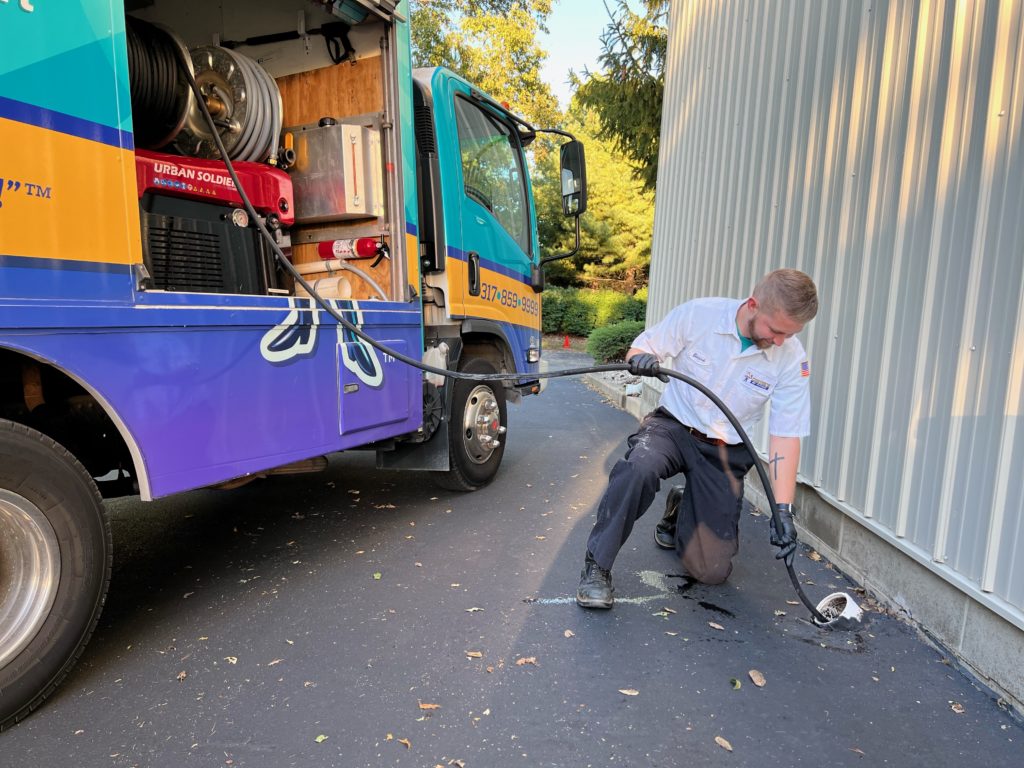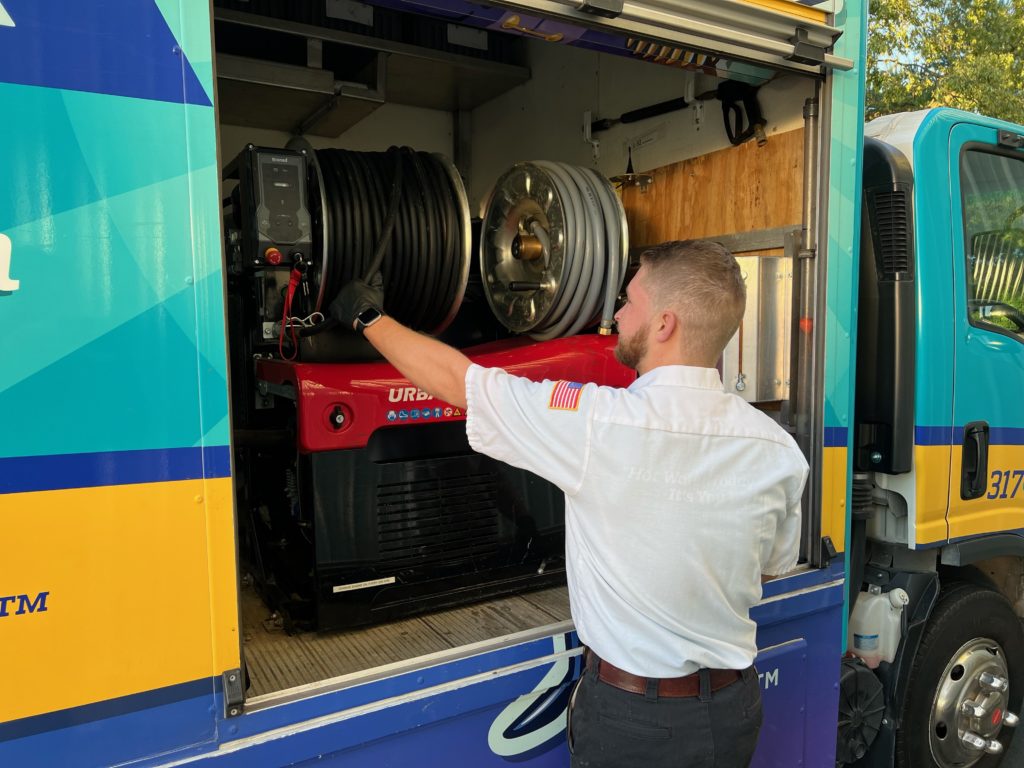Table of Contents
Every homeowner knows what it’s like to deal with slow drains, whether in the kitchen sink, the shower, or elsewhere. There’s much you can do to unclog a drain on a DIY basis, such as using a plunger or a plumbing snake. Some homeowners may even turn to chemical drain cleaners. But sooner or later, you may find that these interventions no longer produce the results you need, pointing out that more extensive action is needed. One of the top options is to hire a hydro jetting service for results that last, something that you can only access via professional plumbers.
At Carter’s My Plumber, we are pleased to offer hydro jetting in the Indianapolis area. In this post, we’ll provide some background information about what this service involves, and when you might need it.

Hydro Jetting Definition
To begin with, what exactly is hydro jetting?
Basically, this is a process wherein your plumber will send high-pressure water through your pipes, unclogging drains while also shaking loose any debris that’s clinging to the inside of your pipes. Generally, the hydro jetting process involves your entire plumbing system. Think of it as a comprehensive clean-out for your entire household.
The use of intense water pressure not only unclogs your pipes, but it may also prevent future clogs and build-up. That’s because the water will wipe the inside of your pipes clean, removing any residual grease, gunk, food particles, or mineral debris. Sometimes, hydro jetting can even be an effective way to remove tree root remnants, one of the most insidious causes of blocked pipes and sewer lines.
It’s crucial to find a plumbing company that actually has the proper equipment. Not every plumbing company is going to have a hydro jet. In fact, only a select few will have one. They are expensive and it is important to have the right skill and knowledge to operate the equipment.
What to Expect from Hydro Jetting
If you’re a homeowner and you’re on the fence about hiring a plumber to perform hydro jetting, it may help to have a clearer sense of what the process entails.
First, your plumber will perform an inspection of your household plumbing system, getting a better idea of where the clogs seem to be located. The plumber will then identify a specific place to insert the hose, through which the water pressure can be applied.
But of course, hydro jetting isn’t just about inserting a hose and turning on the water. If approached haphazardly, hydro jetting can actually endanger the integrity of your pipes. For this reason, this isn’t something to be attempted on a DIY basis. Instead, you’ll always want to trust the services of a local plumbing company.
Here’s a little more detail about the steps involved in the hydro jetting process:
Initial Inspection
Typically, plumbers conduct full video inspections to assess where the blockages are, and also to identify any damaged pipes that may need to be replaced. In some cases, particularly with very old pipes, the inspection may lead your plumber to conclude that the pipes can’t withstand intense water pressure. If that’s the case, then your plumber will simply clean the pipes with an auger, which isn’t quite as effective as hydro jetting but can still help fix your slow drains.
In addition, you may be advised to install new, more robust piping.
Cleaning
After the inspection comes the cleaning itself. Basically, your plumber will deploy hoses into your pipes and sewer lines and then turn on the water. Most hydro jetting machines can provide pressure of up to 4,000 psi, but your plumber will determine exactly how much pressure is required for your system (and how much pressure your pipes can take without damage). Note that this is extremely forceful: Your household water pressure probably tops off at 40 to 60 psi.
The water pressure scours the inside of your pipes and loosens any debris or build-up. All of that debris is then flushed through the plumbing system, simply due to the force of gravity.
Hydro Jetting to Remove a Tree Root
There’s no question that using a hydro jetting machine can help you eliminate things like grease, mineral buildup, and food particles… but what about tree roots that get lodged in your pipes?
The short answer is that yes, hydro jetting can often work to clear tree roots. During the initial video inspection, your plumber will identify any tree roots that have grown into your pipes, and assess the level of damage the root has done. If the damage is minimal, then it may be possible to rectify the problem with the use of a hydro jetting system. If not, your plumber will recommend alternative methods.
What Else Can You Remove with a Hydro Jet?
Beyond tree roots, there are a number of other issues that you can effectively clear out with hydro jetting. Some of the most common examples include:
- Hair clogs
- Mineral deposits along your pipe wall
- Grease and fat inside your pipes or your sewer pipe
- Silt
- Sand

Finding the Right Hydro Jetting Provider
The most important thing to know about hydro jetting is that it’s something best left to the professionals. If you live in the Indianapolis community and are looking for a trusted, qualified plumbing company with decades of experience, look no further than to Carter’s My Plumber. We’d love to give you an estimate for our hydro jetting services. Reach out to our team at any time.
Frequently Asked Questions
We are always happy to address any specific inquiries about hydro jetting. Here are just a few of the most common ones:
Is hydro jetting better than snaking?
Hydro jetting is a more aggressive approach, which means it can offer a more comprehensive result and also get rid of more stubborn clogs. With that said, it also entails a bit more risk to older or weakened pipes.
Is hydro jetting the same thing as drain cleaning?
Hydro jetting is fascinating technology and it will get the job done to make sure the clog is relieved and removed. If a homeowner wants to ensure their problem is removed, jetting is the way to go. There is a huge difference between drain cleaning and jetting. Jetting is based on water pressure whereas a drain cleaning is a line being inserted into a pipe to chop up the clog.
How much does hydro jetting cost?
The cost for hydro jetting can vary between $250 and $800 for a residential application, $500 to $2500 for commercial. The pricing is dependent on the severity of the clog. Carter’s My Plumber offers free estimates for difficult clogs, like a whole-house clog.
Can hydro jetting damage pipes?
In the wrong hands, hydro jetting can definitely take a toll on your pipes. That’s why it’s so important to hire a professional plumber, rather than attempt a DIY approach.
Does hydro jetting work on roots?
If the root has done just minimal damage to the pipe itself, then yes, hydro jetting may be a very effective solution. Given that roots often cause sewer backups, this is definitely something to keep in mind, and can be considered a form of preventative maintenance.
Can you hydro jet a toilet?
Hydro jetting is a whole-house, system-wide approach, but can definitely be an effective way to eliminate toilet clogs.



